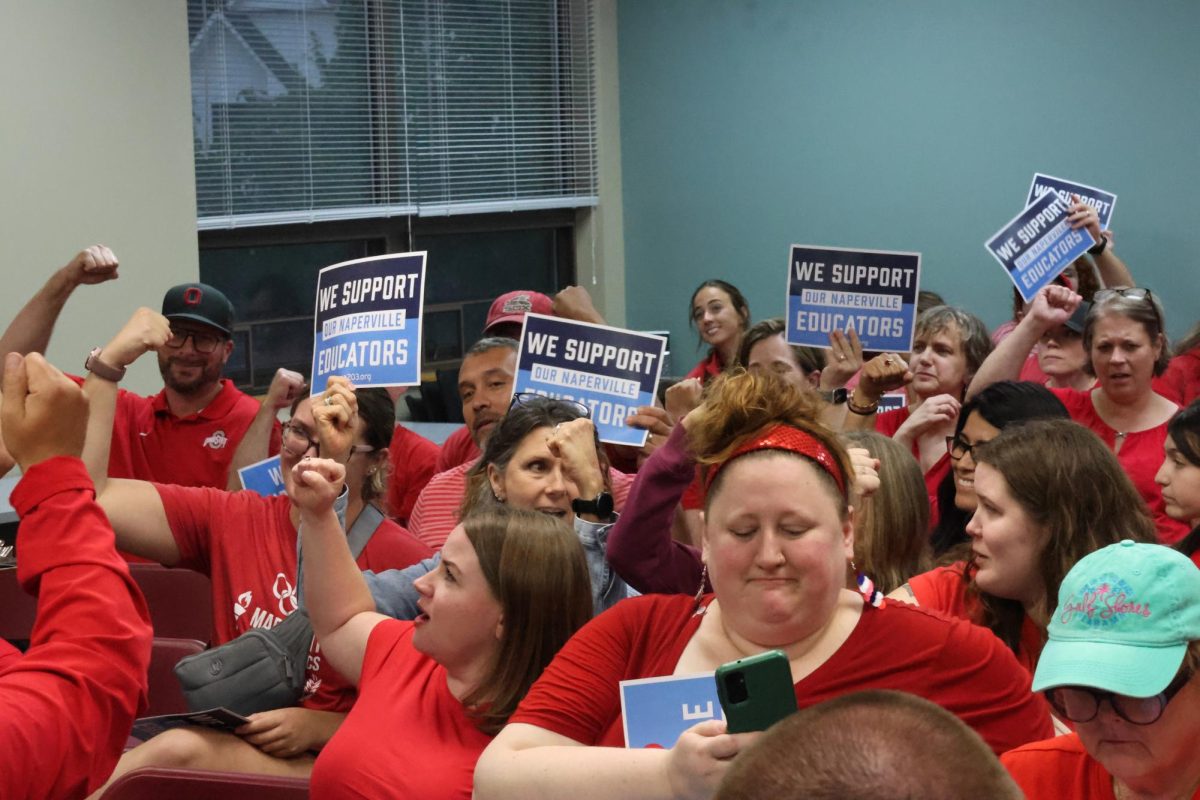Teachers, parents and community members packed Naperville School District 203’s Aug. 18 board meeting as stalled contract talks raised the prospect of a strike as early as Aug. 25.
The current salary contract between the district and the Naperville Unit Education Association expired June 30. The union voted Aug. 13 to authorize a strike, giving its leaders the ability to call a walkout if meaningful gains and compromises have not been reached. Negotiations that began in February have stalled primarily over salary increases, with teachers arguing District 203 lags behind neighboring districts and the district maintaining its offer is both competitive and economically sustainable.
The district’s current offer includes what it calls a 4.9% raise in the first year and a 4.94% raise in the second year. Raises in the third and fourth years would be tied to inflation under the state’s property tax cap law but limited to a 5% increase.
The district has also offered continued board-paid health benefits and estimates teachers would receive a compounded raise of more than 10% in the first two years. At first glance, those figures appear larger than the union’s counterproposal of a 3.9% raise in the first year and 3.75% in the second, followed by cost-of-living increases linked to the Consumer Price Index with a minimum of 3% and a maximum of 5%. But union leaders say the comparison is misleading, because the district’s calculations include step increases and annual raises teachers already receive based on years of service.
The district’s flat-dollar approach also means newer teachers would see a larger percentage increase than veteran teachers, something the union argues creates inequities. NUEA leaders contend their proposal is clearer, more consistent and more equitable over time.
Before the 7 p.m. board meeting on Monday, dozens of teachers marched together from Naperville Central High School to the district office at 5:30 p.m. to make a unified entrance. A severe storm rolled in as the group gathered, bringing heavy rain, thunder and frequent lightning. Despite the conditions, the group was not allowed inside until about 6:20 p.m., leaving many huddled under umbrellas and building overhangs as lightning was visible nearby.
Rob Hunt, a Ranch View Elementary School teacher, and a member of NUEA’s leadership team, eventually knocked on the doors to get the attention of staff inside.
“With the storm escalating in severity and lightning coming closer, I was increasingly concerned about the dozens of people seeking shelter,” Hunt said. “It was a very real public safety concern. We were locked out for over 45 minutes in the storm.”
During the meeting’s public comment section, which spanned three hours, parents and teachers urged the board to support educators.
“If we expect our students to treat one another with dignity, then district leadership must demonstrate that same dignity in how they treat their staff,” educator Julie Walsh said.
Others questioned the district’s financial reasoning, arguing that they had the resources to meet teachers’ demands.
“Let’s be clear,” community member Susan Farnon said, “District 203 is not broke.”
Several teachers also voiced frustration with the contract proposal.
“This is how you are choosing to compensate some of your most dedicated, experienced teachers,” Tracey Pisarski, a longtime educator at District 203, said, “Teachers who have invested decades of their lives to this community.”
Board President Charles Cush has continued to defend the district’s proposal as both competitive and sustainable.
“We simply cannot afford the union’s proposal without a significant impact on the community [tax increases] or the students we serve [program and staff reductions,]” Cush wrote in an email addressing Naperville 203 staff members on Aug. 15. “To maintain a balanced budget, recurring expenses must not exceed revenue.”
The district claims its latest offer would make Naperville teachers among the highest-paid in the region.
“Our offer is strong and competitive with raises across all four years, including a compounded raise of over 10% in the first two years alone and continued excellent health benefits,” Cush said.
For a newer teacher earning around $50,000, the district’s flat-dollar approach could result in a raise closer to 5%, while a veteran teacher might only see less than a 1% increase under the same plan. The union’s proposal, in contrast, would apply percentage increases consistently across the salary schedule, giving both early-career and longtime teachers the same proportional bump.
In a district email addressed to educators on Aug. 18, Dr. Meredith Haugens, assistant superintendent of Human Resources, detailed an extended raise for veteran teachers, responding to concerns of disproportionate raises from the NUEA.
“In order to recognize the long-term service of educators, those in longevity positions [after step 23] would receive an additional $1,200 in their annual raise in addition to the set dollar increase for every educator,” Haugens wrote.
Step 23 is achieved when a teacher has taught for 22 years, being one of the final “tiers” in the salary schedule.
The least an educator can make after step 23 is about $119,000, making a $1,200 bonus 1% of their total salary.
A federal mediator has been appointed to oversee new bargaining sessions scheduled for Aug. 19–21. If no agreement is reached, the earliest possible strike date remains Aug. 25.
Both sides continue to insist they want to avoid a strike.



